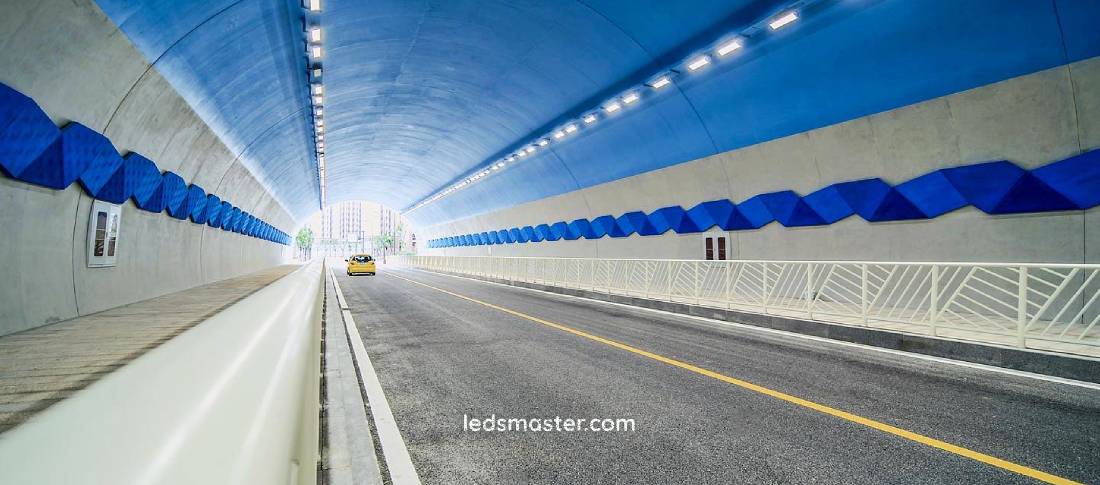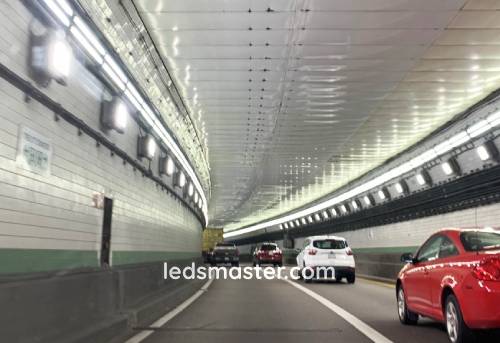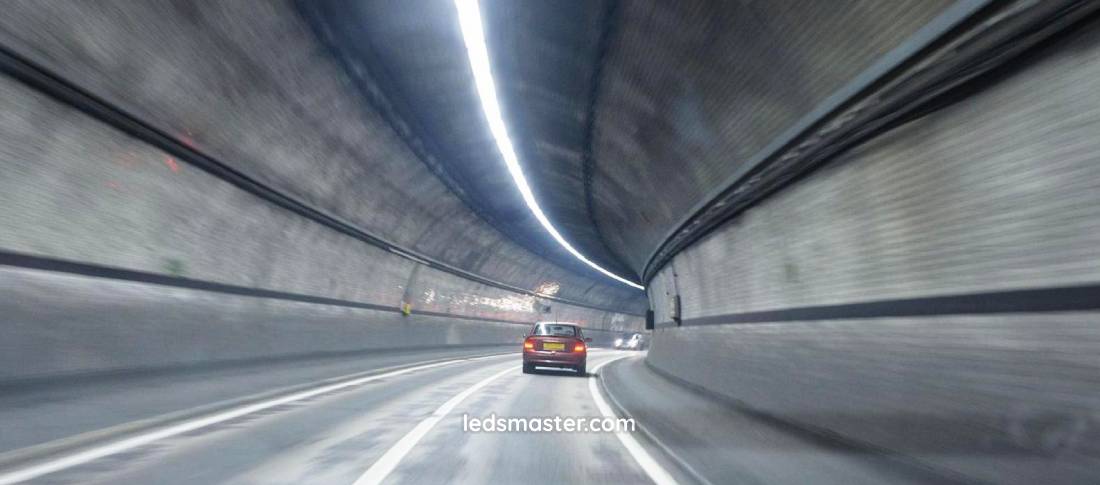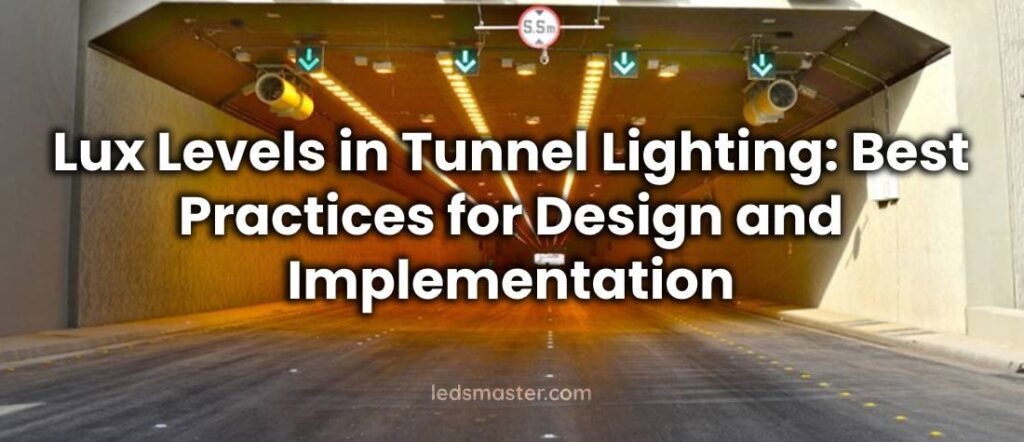Tunnel lighting plays a vital role in ensuring safe navigation through underground or enclosed spaces. Effective tunnel lighting ensures that drivers, pedestrians, and cyclists can clearly see their surroundings, reducing the risk of accidents. Lux levels are a key factor in the design of tunnel lighting systems, as they determine the amount of light provided at any given point within the tunnel. Achieving the right lux levels requires careful consideration of various factors, including tunnel geometry, traffic flow, and energy efficiency. Understanding how lux levels interact with these variables allows for the creation of lighting designs that optimize visibility and safety without excessive energy consumption.
Table of Contents
ToggleUnderstanding Lux Requirements in Tunnel Lighting

Lux is a unit of measurement used to quantify the intensity of light that falls on a given surface, providing a clear indication of how well-lit an area is. In the context of tunnel lighting, lux levels are crucial for ensuring proper visibility and safety. The required lux levels within a tunnel are determined by several factors, including the size and shape of the tunnel, the type of traffic passing through, and the technology used for the lighting system. Given the variety of tunnel environments, each one may have distinct lux requirements. As such, designing lighting solutions for tunnels is not a generic process but one that demands customization based on specific needs and conditions.
The process of calculating the required lux levels involves detailed assessments that take into account various elements, such as the tunnel’s dimensions, traffic types, and usage frequency. Road tunnels, for example, may have different lux needs compared to rail or pedestrian tunnels. For tunnels intended for vehicular traffic, it is crucial to ensure that drivers have enough illumination to see lane markings, road signs, and other vehicles clearly. On the other hand, tunnels for pedestrian use may not require the same level of intensity but should focus on creating a safe and navigable environment. As such, lux levels must be tailored to the specific requirements of each type of tunnel and its intended users.
Lighting Solutions for Different Tunnel Types
Each type of tunnel comes with its own specific set of requirements when it comes to lighting design. Whether the tunnel is intended for road traffic, trains, or pedestrian use, the primary goal of the lighting system remains the same: to ensure that users can navigate safely and efficiently through the space. However, the unique characteristics of each tunnel type—such as traffic flow, user behavior, and environmental factors—necessitate distinct approaches to lighting design. The lux levels required, the distribution of light, and the technologies employed all differ significantly based on these factors. Understanding these differences is crucial in designing an effective lighting system that meets both safety standards and energy efficiency goals. Below is a closer look at the lighting design considerations for road, rail, and pedestrian tunnels.
Lighting Lux Level Requirements for Different Tunnel Types
| Tunnel Type | Lux Level Range | Lighting Focus |
|---|---|---|
| Road Tunnel | 100 – 200 lux | General and directional lighting to ensure driver visibility, minimize glare, and maintain consistent illumination. |
| Rail Tunnel (Track Area) | 50 – 100 lux | Focused lighting for clear visibility of tracks and signals. |
| Rail Tunnel (Platform/Station Area) | Up to 300 lux | Increased lux levels for passenger safety during boarding and disembarking. |
| Pedestrian Tunnel | 50 – 150 lux | Even light distribution to create a safe, inviting environment for pedestrians. |
Road Tunnel Lighting Design
 Road tunnels are primarily designed for vehicular traffic, meaning the lighting system must ensure drivers can clearly see lane markings, road signs, and other vehicles in all conditions. Lux levels for road tunnels must be sufficient to allow drivers to navigate safely, especially in low-visibility conditions such as nighttime or inclement weather. The lighting must be designed to minimize glare, which can impair vision, and reduce shadows that might create visual obstacles for drivers. Excessive light intensity should be avoided, as it could cause discomfort or temporary blindness, particularly when transitioning from bright outdoor environments into the darker tunnel spaces.
Road tunnels are primarily designed for vehicular traffic, meaning the lighting system must ensure drivers can clearly see lane markings, road signs, and other vehicles in all conditions. Lux levels for road tunnels must be sufficient to allow drivers to navigate safely, especially in low-visibility conditions such as nighttime or inclement weather. The lighting must be designed to minimize glare, which can impair vision, and reduce shadows that might create visual obstacles for drivers. Excessive light intensity should be avoided, as it could cause discomfort or temporary blindness, particularly when transitioning from bright outdoor environments into the darker tunnel spaces.
In terms of lighting technology, road tunnels often use a combination of general and directional lighting. General lighting provides consistent illumination along the length of the tunnel, while directional lighting is used to highlight lane markings and road signs to guide drivers. A common lighting setup for road tunnels involves mounting lights on the ceiling at regular intervals to provide uniform illumination across the tunnel. The distribution of light within the tunnel is designed to avoid abrupt contrasts between the well-lit areas and shadowed spots, which could create visual distractions or hazards. Additionally, the lights may be adjusted according to the traffic flow. For example, during periods of low traffic, the lighting may be dimmed to conserve energy, while during peak traffic hours, the lux levels are increased to ensure enhanced visibility.
Figures for road tunnel lux requirements vary depending on tunnel length, traffic conditions, and local standards, but typically, road tunnels are designed to meet a range of between 100 to 200 lux in the tunnel’s general illumination zone. These levels can be adjusted for different areas of the tunnel, such as the entrance, middle, and exit, where varying lighting is required based on external light conditions.
Rail Tunnel Lighting Design
Rail tunnels serve a different purpose and therefore have distinct lighting needs compared to road tunnels. In rail tunnels, the lighting must ensure that train operators have clear visibility of the track and signals at all times. Given that rail tunnels often serve less frequent but faster-moving trains, lux levels in these tunnels must provide adequate visibility even at high speeds. The lighting system is generally designed to be much more focused than in road tunnels, with an emphasis on illuminating the tracks and railway signals clearly.
The lighting in rail tunnels usually incorporates overhead lights positioned above the tracks, as well as side-mounted lights that illuminate specific areas of interest, such as switches and signal posts. The lighting system must also be able to accommodate the presence of both moving trains and stationary objects along the track. As trains typically travel at higher speeds than road vehicles, the lighting design must provide consistent and uniform lux levels along the entire length of the tunnel. Additionally, rail tunnels that include platforms or stations within the tunnel require increased lux levels at those locations to ensure passenger safety during boarding and disembarking, especially in emergency situations or low-visibility conditions.
In terms of figures, rail tunnels generally have lux requirements ranging from 50 to 100 lux for the track area and up to 300 lux for the platform or station zones. The lighting system in these tunnels must also be carefully monitored to ensure it can respond to changing conditions, such as train speed or varying passenger traffic.
Pedestrian Tunnel Lighting Design
Pedestrian tunnels serve a completely different set of users and, as such, require a unique approach to lighting design. The lighting system for pedestrian tunnels must create a safe, inviting environment for individuals traveling on foot, whether it’s commuters, tourists, or local residents. Since pedestrians are generally walking at much slower speeds compared to vehicles or trains, the lighting doesn’t need to be as intense. However, it still needs to ensure that all areas of the tunnel are well-lit, minimizing dark spots that could create potential hazards. The lux levels required for pedestrian tunnels are typically lower than those for road or rail tunnels, but they still need to provide adequate visibility to support safe movement.
In pedestrian tunnels, lighting is often focused on providing even illumination throughout the entire space. The goal is to avoid uneven lighting that could create areas of high contrast or shadow, which might confuse or disorient pedestrians. Additionally, there is often an emphasis on creating an aesthetically pleasing environment, particularly in tunnels located in public spaces or tourist areas. Decorative lighting elements, such as color-changing LEDs or artwork integrated into the tunnel walls, can enhance the visual appeal while still meeting the necessary safety standards.
Lux levels in pedestrian tunnels typically range from 50 to 150 lux, depending on the tunnel’s design, usage frequency, and location. For example, tunnels located in high-traffic areas may require higher lux levels to accommodate the volume of pedestrians, while tunnels in quieter areas may have lower lux requirements. The overall goal in pedestrian tunnel lighting design is to balance safety with user comfort, ensuring that the environment is not only functional but also welcoming and visually engaging.
In more complex or urban tunnels, additional features such as emergency lighting systems are integrated into the design. These lights provide essential illumination during power outages or emergency situations, guiding pedestrians safely out of the tunnel. Emergency lighting is typically designed to function at higher lux levels, ensuring visibility even in extreme conditions.
In terms of figures, pedestrian tunnels generally require lux levels of around 100 lux at the tunnel’s entrance and progressively lower levels (50-80 lux) towards the tunnel’s interior, with an emphasis on keeping the lighting even across the length of the tunnel.
Each type of tunnel comes with its own specific set of requirements when it comes to lighting design. Whether the tunnel is intended for road traffic, trains, or pedestrian use, the primary goal of the lighting system remains the same: to ensure that users can navigate safely and efficiently through the space. However, the unique characteristics of each tunnel type—such as traffic flow, user behavior, and environmental factors—necessitate distinct approaches to lighting design. The lux levels required, the distribution of light, and the technologies employed all differ significantly based on these factors. Understanding these differences is crucial in designing an effective lighting system that meets both safety standards and energy efficiency goals. Below is a closer look at the lighting design considerations for road, rail, and pedestrian tunnels.
Factors Influencing Lux Levels

The design of tunnel lighting systems must take into account a variety of factors that influence the appropriate lux levels for a particular environment. The type of tunnel plays a central role in determining these requirements. A road tunnel, for example, serves a different purpose than a rail tunnel, and thus, their lighting systems should be designed differently. Additionally, the level of traffic that the tunnel is expected to accommodate can significantly impact the required lighting. Tunnels with high traffic volumes, such as those in urban centers or highways, often need more intense illumination compared to tunnels with lighter traffic. This is because increased traffic can cause additional complexity in terms of visibility and safety, demanding higher lux levels to ensure that all users can clearly see and respond to their surroundings.
Environmental factors are another critical consideration in determining lux levels. Natural light can influence the amount of artificial lighting required, particularly in tunnels that are not completely enclosed or those with large openings at either end. The amount of sunlight that enters a tunnel can reduce the need for artificial illumination during certain times of the day. Additionally, the reflectivity of the tunnel’s surfaces, such as walls, ceilings, and roadways, can affect the lighting design. Highly reflective surfaces may amplify the light, reducing the overall energy required to achieve the desired lux levels. Conversely, darker or more absorbent surfaces may require more artificial light to meet the necessary visibility standards. These environmental factors must be carefully considered when determining the appropriate lighting system and its corresponding lux requirements.
Impact of Tunnel Geometry on Lux Levels
The geometry of the tunnel itself has a profound impact on the lux levels required for adequate illumination. Tunnels come in a variety of shapes and sizes, each with unique challenges when it comes to lighting. Straight tunnels are generally easier to illuminate evenly, as light distribution can be uniform throughout their length. However, tunnels with curved or irregular shapes may require more complex lighting solutions. Curved tunnels, in particular, can create variations in light distribution, as the angles of the walls and ceiling affect how light travels and spreads across the tunnel surface. In these cases, additional light sources or strategic placement of lighting fixtures may be necessary to ensure that lux levels remain consistent and that all areas of the tunnel are adequately illuminated.
The height and width of the tunnel are also important factors to consider when determining the required lux levels. Taller tunnels may require higher intensity lighting to ensure that light reaches all areas, including the farthest sections of the tunnel. Similarly, wider tunnels may need to incorporate more light sources to maintain uniform lux levels across the expanse. The distribution of light in these tunnels must be carefully planned to prevent dark spots or areas with insufficient illumination. In contrast, narrower tunnels may need less lighting to achieve the same effect, as the light is more concentrated and has a smaller area to cover.
More complex tunnel designs, such as those with multiple lanes or intersections, require advanced lighting systems to ensure that lux levels are adequate across the entire structure. These tunnels often have more varied lighting needs, and the design must take into account factors such as the interaction between traffic flow, the placement of light sources, and the geometry of the tunnel. Moreover, the use of different lighting techniques, such as directional lighting or recessed lighting, can help maintain optimal lux levels in these more intricate tunnel layouts. The overall goal in these cases is to provide clear and even illumination that enhances safety and visibility while minimizing energy consumption.
Energy-Efficient Lighting Solutions for Tunnels
Energy consumption is a major consideration in the design of tunnel lighting systems. Given the long operational hours of many tunnels, selecting energy-efficient lighting options is key to reducing operational costs. Advances in lighting technology have led to the development of solutions that provide high levels of illumination while consuming less energy. LEDs, for example, are commonly used in tunnel lighting due to their efficiency, long lifespan, and ability to provide consistent illumination over extended periods.
Choosing LED Technology for Tunnel Lighting
LED lighting has become the preferred solution for many tunnel lighting projects. LEDs offer several advantages over traditional lighting technologies, including higher energy efficiency, longer lifespan, and lower maintenance requirements. The ability to control the intensity of LED lights also allows for greater flexibility in adjusting lux levels based on traffic flow and environmental conditions. LED lights can also be dimmed during off-peak hours to save energy while still maintaining adequate lighting for safety.
Other Energy-Efficient Lighting Options
In addition to LED technology, other lighting solutions can also contribute to energy savings in tunnel lighting systems. For example, induction lamps and fluorescent lights are alternatives that may be considered depending on the specific needs of the tunnel. Solar-powered lighting systems are another innovative solution, especially in tunnels located in areas with high levels of sunlight. By integrating renewable energy sources, tunnels can further reduce their environmental impact while maintaining the required lux levels for safety and visibility.
Monitoring and Maintaining Lux Levels
Once a tunnel lighting system has been installed, it is important to regularly monitor and maintain the lux levels to ensure they remain consistent over time. Changes in tunnel conditions, such as increased traffic flow or wear on the lighting fixtures, can affect the intensity of the light. Periodic inspections and maintenance routines help to identify and address any issues that might compromise the effectiveness of the lighting system.
Regular Inspections for Consistent Lighting
To ensure that the lighting system remains in optimal working condition, regular inspections are required. These inspections should evaluate the condition of the light fixtures, measure lux levels at various points within the tunnel, and check for any areas where light intensity may have diminished. Regular inspections help identify potential issues, such as faulty bulbs or obstructions that block light distribution, which could impact safety. Timely maintenance can prevent more serious issues from developing and ensure that the tunnel remains well-lit and safe for users.
Upgrading Lighting Systems Over Time
As technology advances, older lighting systems may become outdated or less efficient. Periodically upgrading the lighting system can help maintain optimal lux levels while taking advantage of improvements in lighting technology. Upgrading to newer LED systems, for instance, can enhance energy efficiency and reduce maintenance costs in the long term. Additionally, new systems might offer better control over lighting levels, allowing for greater adaptability to changing tunnel conditions.
Final Considerations in Tunnel Lighting Design
Designing effective tunnel lighting systems requires a balanced approach that considers various factors, such as lux levels, energy efficiency, and safety. Achieving the right lighting in tunnels involves understanding the specific needs of each tunnel type, whether it be for road, rail, or pedestrian use. Energy-efficient solutions like LEDs and other advanced technologies contribute to reducing operational costs while maintaining high standards of safety. Regular monitoring and maintenance of the lighting system ensure that lux levels remain consistent and that any potential issues are addressed promptly. By focusing on these factors, tunnel lighting designs can meet the functional requirements while also contributing to a safer and more sustainable environment for all users.

